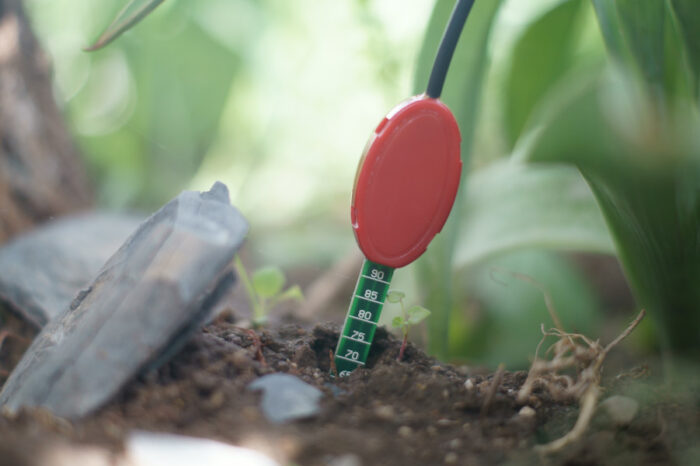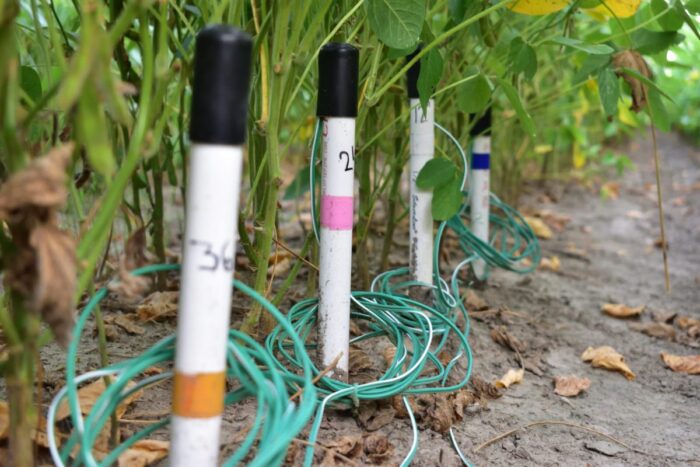Soil moisture sensors are used to measure and monitor the water content in the soil. These sensors function by measuring the resistance of water molecules in and around soil particles, which is then translated into a percentage. They can either be placed in the ground or on a tree’s leaves, and they provide accurate readings of soil moisture levels to help people better manage their crops, lawns, and gardens.
Types of Soil Moisture Sensors

Source: vegetronix.com
Depending on whether you need data for a large-scale application or for home use, there are several types of sensors available.
Resistive Soil Moisture Sensor:
This type of sensor measures both electrical resistance and capacitance in the soil to determine the amount of water present. It is composed of two stainless steel electrodes that measure an alternating current passing between them. The frequency and impedance of this current depend on the size, shape, humidity level, and type of material between them – i.e., either air or soil particles.
Time Domain Reflectometry (TDR):

Source: soilsensor.com
TDR works by sending an electromagnetic pulse along a small probe (a metal rod buried underground) connected to a source coaxial cable that runs along the entire length. This probe then reflects different levels of electrical signals due to its interaction with surrounding materials in different parts along its length – either air or moisture-laden soil particles – back to a receiver at one end. Based on this data, it is used extensively in agriculture for mapping out irrigated areas as well as wet spots more precisely than resistive sensors can do alone.
Thermo-optical Probes:
These probes work by combining TDR techniques with infrared probes that detect heat generated by sun radiation absorbed by moist soil particles where they are placed underground along with emitter rods that send infrared light signals into surrounding soils. Infrared rays don’t penetrate dry soils due to their low thermal conductivity; instead, they reflect back at different wavelengths according to varying moist levels present around them until some are fully absorbed when the saturation point is achieved near causeways or drainage channels used for supplying irrigation water from one area another far away from base station network nodes within farms setup extensively.
Why use them?

Source: bobvila.com
- Improved irrigation efficiency: Soil moisture sensors can be used to monitor the amount of water in the soil, helping ensure that optimal levels are maintained with minimal wastage. This makes it easier for growers to prevent drainage problems, leaks, or too much watering for their plants.
- Save time and money: By measuring how much water is absorbed by the soil, growers can reduce or eliminate guesswork from their irrigation process and help save both time and money in the long run.
- Monitor drought conditions quickly: The ability to monitor moisture levels frequently provides an early warning if drought conditions start to become an issue in a particular area or crop season; allowing growers to respond quickly and take necessary action accordingly.
- Reduce water consumption: By being able to measure the exact amount of water needed, growers can reduce the amount they use overall – helping conserve resources and limit environmental impact by avoiding over-watering plants with too much-untreated runoff flowing into rivers, lakes, or down drains.
Fields of application

Source: reticulationperth.com
Soil moisture sensors are widely used in a variety of applications such as automated irrigation systems, crop and turf management, horticulture, hydroponics, greenhouses, animal husbandry, and managing wet/dry climates. They provide information on soil moisture levels at different depths to ensure optimal plant growth and development, leading to improved crop yield. In addition to this, they can be used to detect potential flooding in low-lying areas.
By providing accurate soil moisture readings from a single source, these tools have revolutionized automated irrigation systems that reduce water usage while improving both crop health & harvest yields. The collected data can help inform growers of optimal times for water application and how much needs to be applied within different areas of the field each season. This data also helps farmers make educated decisions when choosing specific crops based on local climate conditions such as temperature & rainfall levels as well as providing an insight into the makeup of their soils & nutrient availability for maximum efficiency throughout the growing season
How to install

Source: mississippi-crops.com
To successfully install a soil moisture sensor, follow these steps:
- Determine what type of sensor you will be using. Different types of sensors measure different levels of information and certain installation requirements should be taken into account before installation begins.
- Plan out where the sensor will be placed in the garden or farm area. Most of them need to be buried at least four inches beneath the surface, so ensure that it is placed in an area where there is minimal foot traffic or activity by animals or pests that could tamper with them.
- Dig a hole with a shovel according to how deep your sensor needs to be installed and position it in the bottom of said hole, ensuring that all ports are facing upwards toward the ground’s surface. Place 4–6 inches of loose topsoil back over the top of the buried sensor once it is fully inserted into position
- Connect any power cords for digital models to a power source (if applicable) as per manufacturer recommendations and if appropriate secure cords into position with straps so as not to interfere with any animal activity or farming equipment operations from nearby areas
- Stake down cables if applicable for even more secure positioning
- Test for accuracy and calibration through readings provided by the display unit (if available) or contact manufacturer’s representatives if necessary
Conclusion
In summary, a soil moisture sensor is an important tool for measuring the moisture levels in the ground and providing an indication of when irrigation or other corrective measures are necessary. The accuracy of the readings depends on their location, depth, and orientation within the soil. They are available in different designs which can be used for specific applications such as shallow readings or deep measurements. By understanding how to correctly install and maintain a soil moisture sensor, efficient irrigation monitoring and management can be achieved with a minimum of effort and cost.